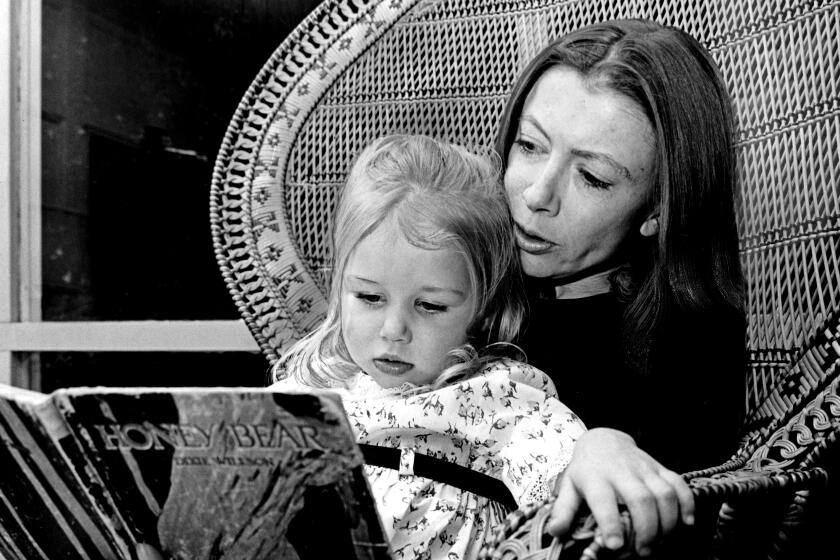Co-Pilot’s View : ANNE MORROW LINDBERGH: A Gift for Life by Dorothy Herrmann , (Ticknor & Fields: $24.95; 479 pp.)
- Share via
Though Anne Morrow and Charles Lindbergh shared an almost pathological passion for privacy, they seldom achieved it, and then, only by voluntarily exiling themselves from the United States.
Anne Morrow Lindbergh has not wanted a biography published during her lifetime, but the vast amount of available material presents an irresistible temptation to a writer. Charles Lindbergh’s solo flight across the Atlantic produced an avalanche of newspaper copy; the tragic kidnaping of the Lindbergh’s first child created a media frenzy, and his openly expressed admiration for Hitler during the 1930s caused rancorous controversy in the press that had once lionized him. The Lindberghs’ lives have attracted an overwhelming amount of attention--as the bibliography to Dorothy Herrmann’s book shows.
Herrmann was able to draw upon the three full-scale biographies of Charles as well as Anne’s own eight books and five published volumes of diaries and letters. Friends and acquaintances offered reminiscences, and Reeve Lindbergh, the youngest daughter, has just published a family memoir thinly disguised as fiction (“The Names of the Mountains,” Simon & Schuster: $19).
While Herrmann’s book seems reasonably definitive even without Anne Morrow Lindbergh’s participation, there are obvious lacunae; the result of those brief periods when the Lindberghs gained the isolation they sought. Even if Anne had cooperated, those gaps might still exist. Though Anne’s published writings seem candid, her personal style is impressionistic and highly metaphorical, veiling some incidents and avoiding others entirely. To her credit, Herrmann usually resists speculation, confining herself to demonstrable fact. The major life events are chronicled; the curiously austere wedding, the horrific kidnaping, the births of the five children, the historic flights, and Anne’s ultimately successful efforts to find an identity of her own as a writer.
The result is informative, respectful, and inevitably somewhat remote. Herrmann becomes judgmental only when discussing Charles Lindbergh’s misguided political sentiments and his adoring wife’s quixotic, ambivalent acceptance of them. Though her husband’s pro-Nazi notions were totally alien to her own family’s liberalism, Anne apparently supported him because she was his loyal wife, an attitude Herrmann clearly finds inexplicable.
This unqualified devotion led Anne to write a 40-page apologia for Charles’ infatuation with German National Socialism. Published in 1940, “The Wave of the Future” was a muddled reflection of the author’s political naivete; a pathetic attempt to reconcile her own humanitarian principles with her beloved husband’s strident isolationism. Though the essay sold well, it all but destroyed the author’s fragile reputation. Within weeks, the Lindberghs became virtual pariahs, regarded by former admirers and friends as fascists. Shunned by their neighbors on Long Island, they moved to an isolated house on Martha’s Vineyard in a futile attempt to escape the controversy surrounding them.
Intransigent as always, Charles Lindbergh continued to express political views that became increasingly repugnant after America entered World War II.
The war years seem to have been particularly difficult for Anne, who found herself not only ostracized by the literary community, but at odds with her husband for the first time in their marriage. Despite her isolation and her misgivings about her work, in 1944 she produced a romantic novella about flying, which was kindly received. With the publication of the poetic, introspective “Gift from the Sea” in 1955, Anne Morrow Lindbergh’s reputation was rehabilitated. Though Charles was still regarded with some suspicion, the appearance of his autobiographical book “The Spirit of St. Louis” in 1953 had restored some of his lost luster. In one of her rare interjections, Herrmann strongly suggests that the success of “The Spirit Of St. Louis” should be credited to Anne, whose distinctive style is clearly evident in the book, so totally different from Charles’ flatly-written earlier account of the epochal flight.
Generally sympathetic to her subject, Herrmann tries valiantly to understand the privileged and sensitive young woman who married the most conspicuous young man in America, and then spent the rest of her life adapting herself to him, an endeavor exponentially more difficult than most marital adjustments. While an occasional note of bewilderment at such unqualified devotion surfaces in the book, Anne Morrow Lindbergh could hardly have found a more generous biographer. For a woman who fought the idea, she was uncommonly lucky. Kendall is a regular reviewer for View.
More to Read
Sign up for our Book Club newsletter
Get the latest news, events and more from the Los Angeles Times Book Club, and help us get L.A. reading and talking.
You may occasionally receive promotional content from the Los Angeles Times.










